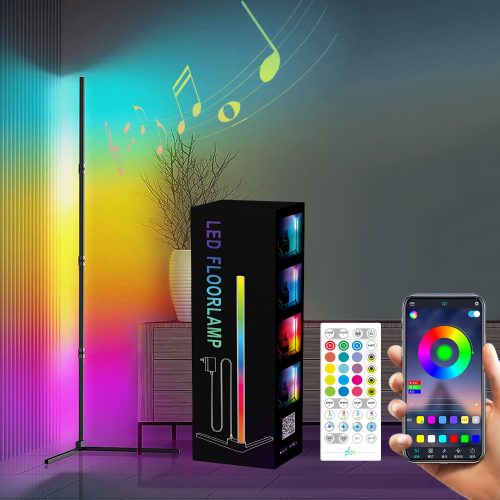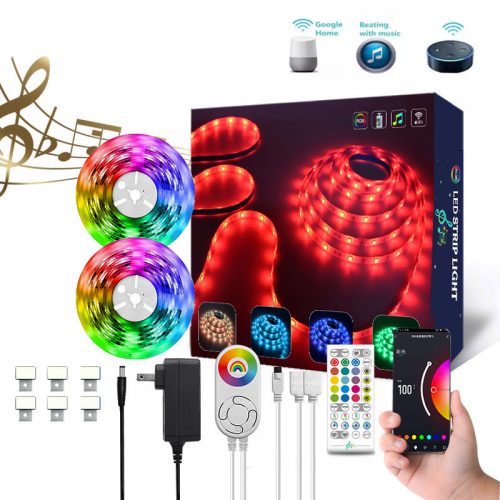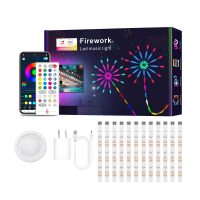In this article, I’m going to perform tests on all of the most popular types of individually addressable RGBIC dream color LED strips lights.
We’re going to talk about their technical specifications, and then I’m gonna help you figure out which one is the best addressable rgbic led strip lights for your project.

First of all, if you’re looking for the best addressable LED strip light. Unfortunately, I can’t give you a single answer, the actual answer is that there are many factors to consider, and each application will likely have one type of strip. That would be best suited for it.
The purpose of this guide is to help you determine what variety of individually addressable digital LED strip lights or best based on the parameters of your project. Of course, one thing you should know is that all the models mentioned below are suitable for your project, if you are looking for Arduino led strip, Adafruit led strip or Govee rgbic led strip lights, etc.
Let’s start by getting a physical look at each addressable led strip type.
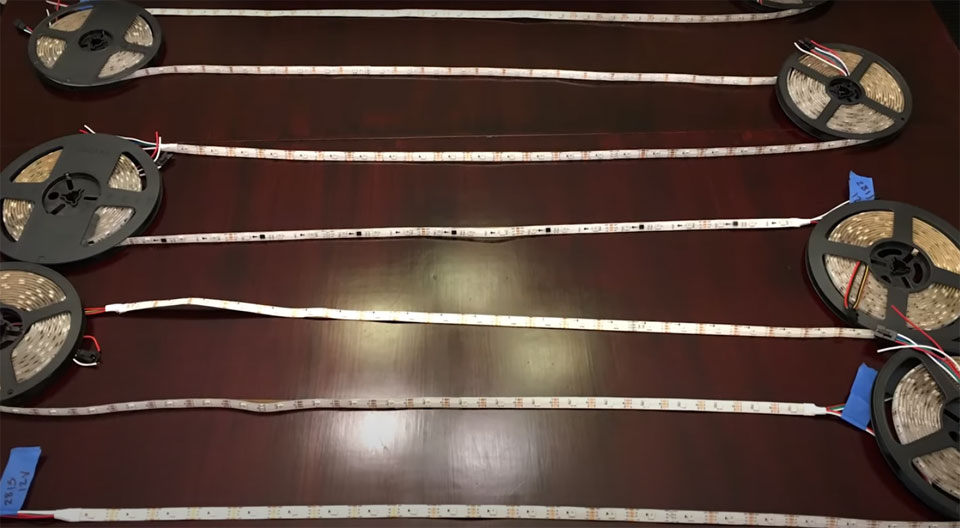
In order to keep my test as standardized as possible, each programable led strip has the same LED density and waterproofing type, specifically, these are all 150 LEDs per 5 meters, and the ip65 silicon coded variety, but there are significantly more varieties to choose from.
1. 4 Options to Select Programmable RGBIC LED Strip Lights
When you select your smart RGBIC LED strips, you’re typically going to get to select a few options.
The first will be the color of the flexible PCB that the chips are mounted on. You can usually choose between black and white, and it really makes no difference.
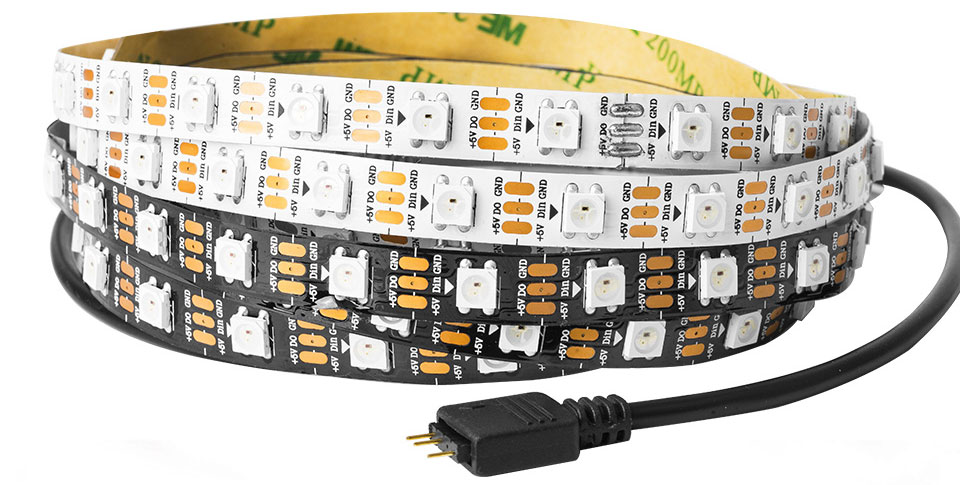
Second is the pixel density or how many LEDs are in a single meter, I tend to use the 30 LEDs per meter variety.
Because it makes power requirements a little bit more manageable. But they come in a variety of densities all the way up to 144 LEDs per meter.

Third, you’ll need to choose what type of waterproofing you want for your project.
As I said before the ones that I’m testing are ip65, which means that they’re coated with flexible clear silicone to keep water, and dust out but they aren’t ready to be submerged in water. In my experience, they are both splash-proof and rainproof.

If you require more waterproofing, you can choose the ip67 version that comes in sealed silicon sleeves.
But keep in mind that they do get a bit annoying if you need to cut the addressable led strips to length.

Of course, if your project is indoors then you won’t need any waterproofing and that option is available as well.
The last choice you need to make is the specific chip that will drive your individually addressable LEDs.
This chip is where each of the addressable led strips gets its name, and I’ll specifically be working with these seven chip types in this article.

2. What is the Pixel LED strips’ work principle
These Pixel LED strip lights all work with the same basic principle, data is sent down a single wire where it’s then read by a small microcontroller chip, that produces a pulse width modulated signal, that controls the brightness of each channel of an LED chip, which contains a red segment, a green segment, and a blue segment.

Each segment can have 256 levels of brightness, which results in 256 to the third power different colors that can be produced.
If you see the term 5050 LED on the product pages, that just refers to the size of the LED chip, not necessarily the type of LED pixel tape or any other components that may be integrated into it.
As for their power draw specifications, in this post, I’ve tested each of the digital led tape.
By first measuring the current draw of the neopixel led strip light with all the LEDs off, then the current draw of a single channel of one pixel, then all the channels of one pixel a single channel of all the pixels, and then the overall current draw for the entire strip with every channel at maximum brightness.
I also evaluated the loss of color accuracy due to the voltage drop on each pixel led strip.
We’re going to begin testing with the oldest model of addressable LED pixel tape that I tested.

3. The Voltage Drop of Addressable LED Light Strip
The ws2811 as a 12-volt addressable led strip shines, when you want to power these strips over large distances, the voltage drop is the term used to describe the difference in voltage at the beginning of a wire run and at the end of that wire run.

Voltage drop is a result of the actual wire, or in this case, the copper traces on the addressable led string contributing a significant amount of electrical resistance.
If your output is 5 volts and you have 2.5 volts over 30 feet, that means you’ll only have 50 percent of your voltage left over, and that means the last LEDs are only going to receive 2.5 volts in total.

4. 12V WS2811 LED Strip VS 5V WS2812B LED Strip
Which is not necessarily enough to accurately produce the colors that you selected.
If you instead start with 12 volts and have that same 2.5-volt drop, that only represents a 21% change in voltage, and the remaining 9.5 volts will produce significantly more accurate colors than that 5-volt ws2812b led strip did.

You can see the difference in color accuracy between the 12-volt WS2811 and the 5 volts ws2812B addressable led strip here when they’re both outputting 100% brightness for the whole led strip light.

The fix for this is to apply power at both ends of the digital LED strip, in a method that’s called power injection.
But in cases where frequent power injection isn’t possible, 12-volt addressable led strips as the WS2811 should typically be favored.
Most of the time WS2811 addressable led strips are the least expensive, but they do come with a few downsides.
Most importantly the cheapest versions of the WS2811 led strip are not truly individually addressable, typically a WS2811 led strip has a single microcontroller that actually powers 3 LED pixels or a total of 9 channels.


This means that it isn’t truly possible to control each LED, but instead, each pixel in your code represents a group of 3 LED chips.

In my tests, the WS2811 addressable led strip light is had one of the highest power usages when no LEDs were lit.
Drawing 1.27 watts of power for their microcontrollers, and lighting the entire strip with pure white pull the total of 1.64 amps.

Which is about 19.68 watts at full brightness you can also see that the color accuracy is really good throughout the entire 5-meter strip, even without any power injection.
Which as I mentioned before, is a huge advantage of the 12-volt ws2811 addressable led strip over the 5-volt ws2812b addressable led strip.
As for use case, the WS2811 addressable led strip should be considered when the cost is an important factor, or when power injection can’t be easily accomplished, but not necessarily if you need to control each pixel individually.
Next up on the list is by far the most common type of addressable digital led strip, the ws2812B led strip lights, which unlike the WS2811 has the controller chip embedded correctly in the LED package, the ws2812B led strip only comes in 5-volt variety, so it’s going to need more power injection than the WS2811 12-volt pixel led strip.

But the smaller components mean less material is required to produce this pixel led strip, and theoretically cost should be lower for the strip’s, where each led can be controlled individually.
In my test, the ws2812B addressable led strip consumed half as much power as the ws2811’s when no LEDs were lit.
But as expected, the power consumption for the LEDs was almost exactly the same at about 60 milliwatts per channel, and the full addressable led strip consumed only 13.6 watts. which is about 6 watts less than the ws2811’s.
I also have another new variety of ws2812B’s called the Eco, in my test the Eco version did have the lowest baseline power consumption needing only 56 milliwatts with no LEDs lit being.

5-volt led strips both types really struggled to reproduce accurate colors near the end of the digital led strip due to voltage drop.
With the Eco version performing slightly worse than the non-eco version in general.
I use ws2812B RGBIC led strip lights as my general-purpose addressable rgb led strips, they’re relatively cheap, they come in a huge variety of pixel densities waterproofing types and strip colors, and they’re compatible with basically every library, that’s meant to control individually addressable LEDs.
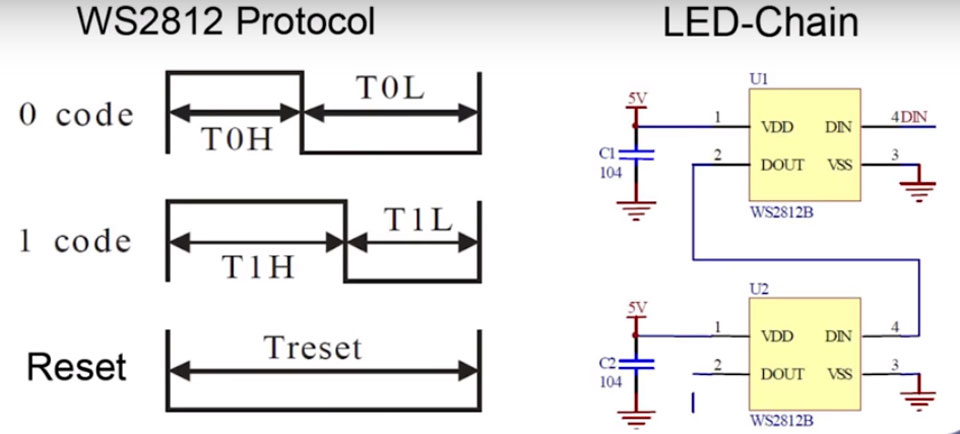
5. 5V SK9822 LED Strip VS 5V WS2812B LED Strip
So what would cause an addressable led string to be incompatible with a library? These libraries control something that’s called chip timing, which is the rate at which the LEDs expect new data.

In addressable led strips that contain the SK9822 chip (Similar APA102), timing is handled a bit differently, instead of having a hard-coded timing that your microcontroller needs to adhere to.
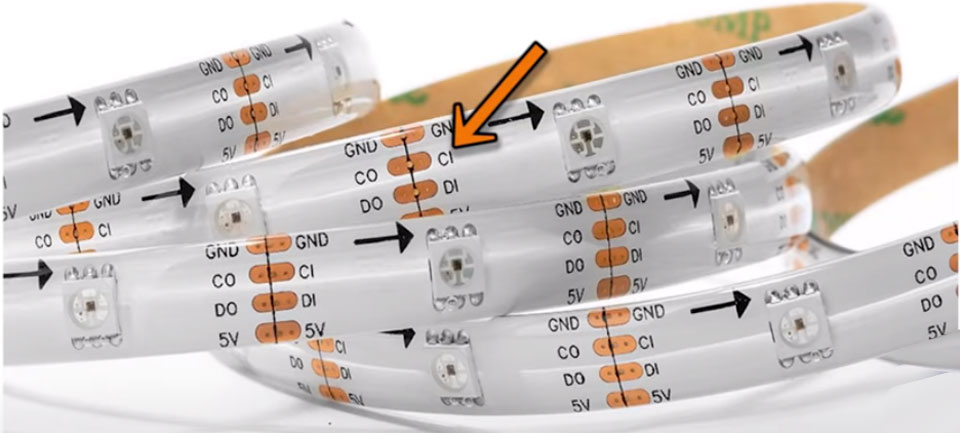
It includes another wire that’s called the clock pin, this clock pin dictates the rate of data transfer between the microcontroller and the chip.
It not only means that the microcontroller can be pushed to its maximum potential by speeding up the rate of the data transfer more than the WS2811 or 2812B’s would allow, but it also allows for the data transfer to be slowed down if frames per second aren’t that important.
And the microcontroller has a significant secondary workload. The SK9822 chips had the highest idle power consumption of any of the 5-volt addressable led strips but had can power consumption numbers for lighting the entire led strip up with full white.
One important thing to note was the significantly worse color accuracy due to voltage drop in these addressable led strip lights.
When you inject power into a ws2812B, it’s generally enough to power each end of a 5-meter LED pixel tape.
But in the SK9822 led strip lights, I would suggest injecting power every two and a half meters to maintain color accuracy.

The SK9822 also costs a little bit more than the WS2812B, and it requires an additional conductor for the clock pin.
But in situations where errors and animations are unacceptable and data accuracy is the most important consideration, the SK9822 addressable led strips are well worth the increase in price.
6. 5V WS2813 LED Strip VS 5V WS2812B LED Strip
The other downfalls a serial communication is that since all the data is being passed over a single wire, any break in the chain will cause the entire strip after that to fail.

The ws2813 addressable led strips are made to address this downfall. on the ws2813, there are two different data lines labeled di and bi, meaning data in and back up in.

This allows the addressable led strip to continue functioning in the event of a dead pixel. Because the bi Channel will act as a pass-through, as long as two consecutive LEDs don’t fail, the rest of the digital led tape should continue to function.

This makes the ws2813 addressable led strips ideal for situations where the strips can’t be accessed for repair, like for instance, if you are going to encase them in epoxy.
Unfortunately, like the SK9822, the WS2813 RGBIC led strip lights performed very poorly in terms of color accuracy.

They exhibited noticeable yellowing after about 45 pixels at full brightness. Aside from that, the power consumption was predictably less given the increased internal resistance, and it required only 12.15 watts for the entire led strip when lit at full brightness. I’d expect this number would go up significantly with more power injection points.
7. The Advantages of WS2815 addressable LED Strip Light
If you want a backup data channel without the voltage drop issues, then the WS2815 may be the answer.

The WS2815 is a 12-volt digital rgbic led strip and as you can see, there is no significant depreciation in color rendering throughout the entire strip, even at full brightness.

The trade-off is price and power consumption, you can see that there’s some odd behavior in the WS2815 when it comes to current draw, basically, a single-pixel draws the exact same amount of current at 50% red as it does at 50% white, even though the white consists of the red, green and blue pixels.
It because that each channel is powered in series instead of in parallel, and if only a single channel is 1, and the other 2 are then shorted out by a transistor or resistor combo, to keep the current constant.
The WS2815 pixel led strip light has both the highest idle power consumption at 3.5 to watts and the highest full white power consumption at 20.18 watts per 150 LEDs.
That being said they’re going to be extremely reliable due to the backup channel, and they are great at reproducing the correct colors despite voltage drop in the strip.
8. 5V SK6812 RGBW IC LED Strip VS 5V WS2812B LED Strip
The WS2815 seems pretty great, but I’ve saved my favorite LED variety for last, the SK6812 is very similar to the ws2812B, and then it requires only 5 volts.

It has an embedded microcontroller and it lacks a backup channel. But the SK6812 has the ability to control an additional channel of LEDs that are used for controlling a large white segment on the 5050 LED package.

Normally RGB LED strip lights produce white by turning the red, green, and blue channels on to the same percentage, which produces slightly blue or purple light.

By having a dedicated white channel on the LED, you can produce a familiar true white light in either warm white, neutral white, or cool white varieties.
It’s true that it does make the programming a little more complicated since you’re sending four channels instead of three but the results are well worth it.
Anytime I’m using LED strip lights in place of normal lightbulbs, I always opt for the RGBW variety for applications like outdoor holiday LEDs.
It’s much less important since I want those to make crazy patterns prefer adding subtle backlighting while still being able to get fancy from time to time, the SK6812 RGBW addressable led strip lights are absolutely the best.
In my test, the 6812 is had a moderately high power consumption at idle of 0.83 watts, and 14.4 when fully lit.
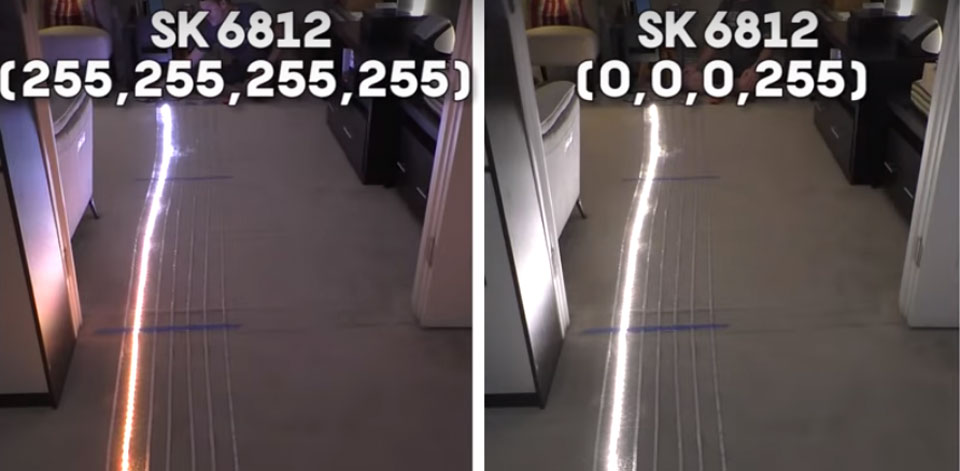
You can also see that they had a significant amount of yellowing around LED 90, but that’s not really a valid test since you wouldn’t produce white light by turning on the RG and B strips.
You’d actually just use the white channel, and while the white channel draws more current than any other single channel lighting.
The whole rgbic led strip light with white results in only 10 watts of power, draw the lowest white power consumption of any of the strips that I tested with the added, benefit of nearly perfect color accuracy throughout the entire led strip without power injection.
So as you can see there’s not really a one-size-fits-all addressable LED strip light, but instead, they all have specific strengths and weaknesses.
If I was forced to pick a single LED strip tape to use in all of my projects, I would absolutely choose the SK6812 RGBW led strips either in warm white or cool white.
Variety depending on my use case, maybe in the future, there’s going to be a 12-volt RGBW SK6812 is my go-to led strip light.












